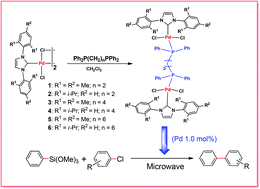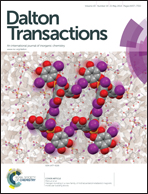Dinuclear NHC–palladium complexes containing phosphine spacers: synthesis, X-ray structures and their catalytic activities towards the Hiyama coupling reaction†
Abstract
Six dinuclear N-heterocyclic carbene (NHC) palladium complexes, [PdCl2(IMes)]2(μ-dppe) (1), [PdCl2(IPr)]2(μ-dppe) (2), [PdCl2(IMes)]2(μ-dppb) (3), [PdCl2(IPr)]2(μ-dppb) (4), [PdCl2(IMes)]2(μ-dpph) (5), and [PdCl2(IPr)]2(μ-dpph) (6) [IMes = N,N′-bis-(2,4,6-trimethylphenyl)imidazol-2-ylidene; IPr = N,N′-bis-(2,6-di(iso-propyl)phenyl)imidazol-2-ylidene; dppe = 1,2-bis(diphenylphosphino)ethane, dppb = 1,4-bis(diphenylphosphino)butane; and dpph = 1,6-bis(diphenylphosphino)hexane], have been synthesized through bridge-cleavage reactions of chloro-bridged dimeric compounds, [Pd(μ-Cl)(Cl)(NHC)]2, with the corresponding diphosphine ligands. The obtained compounds were fully characterized by 1H NMR, 13C NMR and 31P NMR spectroscopy, FT-IR, elemental analysis and single-crystal X-ray crystallography. Moreover, further explorations of the catalytic potential of the dinuclear carbene palladium complexes as catalysts for the Pd-catalyzed transformations have been performed under microwave irradiation conditions, and the complexes exhibited moderate to good catalytic activity in the Hiyama coupling reaction of trimethoxyphenylsilane with aryl chlorides.


 Please wait while we load your content...
Please wait while we load your content...